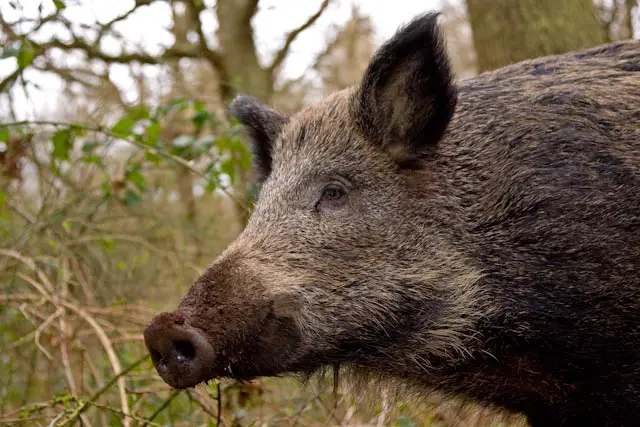The wild boar (Sus scrofa) is medium-size native mammal of Africa and Eurasia. Most species of pigs evolve from the wild boars. While humans make the animals redundant in its natural habitats the wild boar is one such animal which is spread with the human intervention. It is also called wild swine or Eurasian wild pig. The domestication of wild boars started as early as in 7,000 – 6,000 B.C.
Wild Boar Facts
Anatomy
- The adult wild boar has a massive body which is supported on thin legs. It has a short trunk but the head is unusually large. The wild boar’s head makes up one-third of the body length. The larger head helps the animal to dig well.
- Wild boars have got the ability to dig as much as 8–10 cm (3.1–3.9 in) into the frozen ground. No matter how hard the ground is or how big the rocks are, wild boars can upturn rocks averaging 40–50 kg (88–110 lb) in weight.
- They possess long ears but the eyes are extremely small.
- Wild boars are capable to achieve great speed of up to 40 km/h (24.8 mph). The thin legs are probably an adaptation to run faster in short bursts.
- They can jump to a height of about 140–150 cm (55–59 in).
- Males weigh 20 – 30% more as compared to the females.
- The wild boar’s canines are 10–12 cm (3.9–4.7 in) long.
- In the European population males weigh 75–100 kg (165–220 lb) and stand 75–80 cm (30–31 in) tall at the shoulder. The body length grows up to 150 cm (59 in). Females on the other hand have a mean weight of about 60–80 kg (130–180 lb) with shoulder height averaging 70 cm (28 in). They reach body length of 140 cm (55 in).
- In the Eastern Europe, the average weight of males is about 110–130 kg (240–290 lb) and they stand 95 cm (37 in) tall with the body length averaging 160 cm (63 in). The shoulder height of females is about 85–90 cm (33–35 in) with the weight averaging 95 kg (209 lb) and 145 cm (57 in) in body.
- The wild boar is typically recognized by its brown fur along with long bristles. The fur becomes dense along the back.
- With its broad ears, it has developed an acute sense of smell. The vision is however is poor. Wild boars cannot see recognize humans from a distance of about 10 – 15 meters.

Range & Habitat
- The wild boar is thought to occur in a wide variety of habitats including deserts and boreal taigas. The wild boar’s habitats are found at an altitude of about 1,900 to 4,000 meters.
- Wild boars occupy the mountainous regions of Kazakhstan, Carpathians, Caucasus, and Central Asia. The European population prefers to live in marshy habitats, mixed and deciduous forests. The forests must be abundant in beech and oak.
- Some of its population has also been introduced into the North America.
- The wild boar’s habitats include broad-leaved mixed forest, nutpine grooves, and coniferous forests. Their range extends Russian Far East and Turkmenia where trees like Korean pine and Mongolian oak are found.
Feeding Ecology & Diet
- Wild boars have an omnivorous diet as they readily consume tubers, leaves, bark, shoots, bulbs, roots, twigs, and rhizomes.
- During winter boars seem to rely on berries, seeds, and nuts.
- The wild boar’s diet also consists of earthworms, lizards, fish, bird eggs, rodents, frogs, mollusks, snakes and carrion.
- Every day they must take 4,000 – 4,500 calories but it increases in the breeding season. Boars living in the temperate zones eat beechnuts and acorns. Plants make up much of the boar’s diet in the Western Europe. This includes bracken, meadow herb roots, and willow herb.
- Wild boars also prey on young galliforms, leporids, and deer fawns.

Reproductive Biology
- Wild boards are social animals. They live in groups even after the breeding season is over except for adult males which are solitary in nature.
- Male boards leave their groups when they become 8 – 15 months old. Females however remain in the group with their offspring.
- The breeding season ranges from November to January.
- The gestation period lasts 114 – 130 days but sometimes it lasts longer than that.
- Baby boars are called ‘piglets’. The female gives birth to 4 – 6 piglets with the maximum number of babies are 10 – 12 per litter.
- The piglets weigh 600-1,000 grams at birth. The piglets remain in their lair in the first 6 – 7 days.
- The lactation period lasts 2.5 – 3.5 months. The female boar is called ‘sow’. Sow becomes mature at 1 year age.
- The maximum lifespan of a wild boar is about 10 – 14 years but many could survive only 4 – 5 years. The captive boar lives up to 20 years.
- Predators of wild boar’s piglets include snow leopards, brown bears, lynx, yellow-throated martens, and jungle cats.
Conservation Status
Least Concern






Leave a Reply